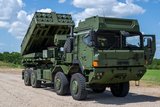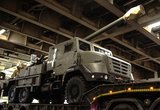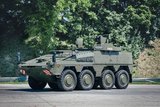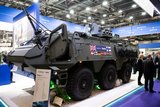Excalibur successfully fired from PzH2000 howitzer
Testing to assess Excalibur’s compatibility and performance with the PzH2000 self-propelled howitzer has been completed at Yuma Proving Ground by the US Army and Raytheon. Ten precision-guided Excalibur projectiles were successfully fired during the final phase of compatibility testing in a live-fire demonstration funded by the US, Germany and supported by Raytheon.
The German Ministry of Defence is evaluating Excalibur within a competitive framework with a down-select planned in 2014.
The testing saw the PzH2000 fire the Excalibur projectiles at targets at ranges from nine to 48km. According to Raytheon, every round delivered precision effects, striking within three metres of the targets, reaffirming warhead lethality and the required three fuse modes.
Raytheon reported that the average miss distance at 48km was less than one metre. Additionally, the PzH2000 test demonstrated the projectile's ability to manoeuvre from the ballistic trajectory to an offset target.
Michelle Lohmeier, vice president, Raytheon Missile Systems' Land Warfare Systems, said: ‘These trials clearly demonstrate Excalibur's ability to provide true precision to the PzH2000, giving warfighters in multiple nations a superior advantage on the battlefield. The PzH2000 is one of many highly capable cannon artillery systems currently deployed, and now we've proven that it can fire the only mature, true precision solution available today.’
These tests follow firings in October that proved Excalibur’s compatibility with the Swedish Archer and US howitzers. The next stage in the programme is a First Article Test for Excalibur Ib to verify its production readiness.
Related Equipment in Defence Insight
More from Land Warfare
-
![Lithuanian 1st Division to achieve initial operating capability in 2026]()
Lithuanian 1st Division to achieve initial operating capability in 2026
Lithuania is one of the countries stepping up its defences in the face of the war in Ukraine with a particular focus on its neighbour and Russian ally Belarus, which has been making incursions into Lithuania’s airspace with balloons and drones.
-
![Beyond Survivability: How Active Protection Systems Are Empowering Commanders (Podcast)]()
Beyond Survivability: How Active Protection Systems Are Empowering Commanders (Podcast)
As threats diversify and intensify, APS are proving essential not just for vehicle protection but also for enhancing operational freedom, effectiveness and mission success in contested environments.
-
Medium knocked out of British Army LMP, with CAVS as heavyweight champion
As the British Army seeks to modernise and consolidate its diverse vehicle fleet, yet another change in direction is underway.






















